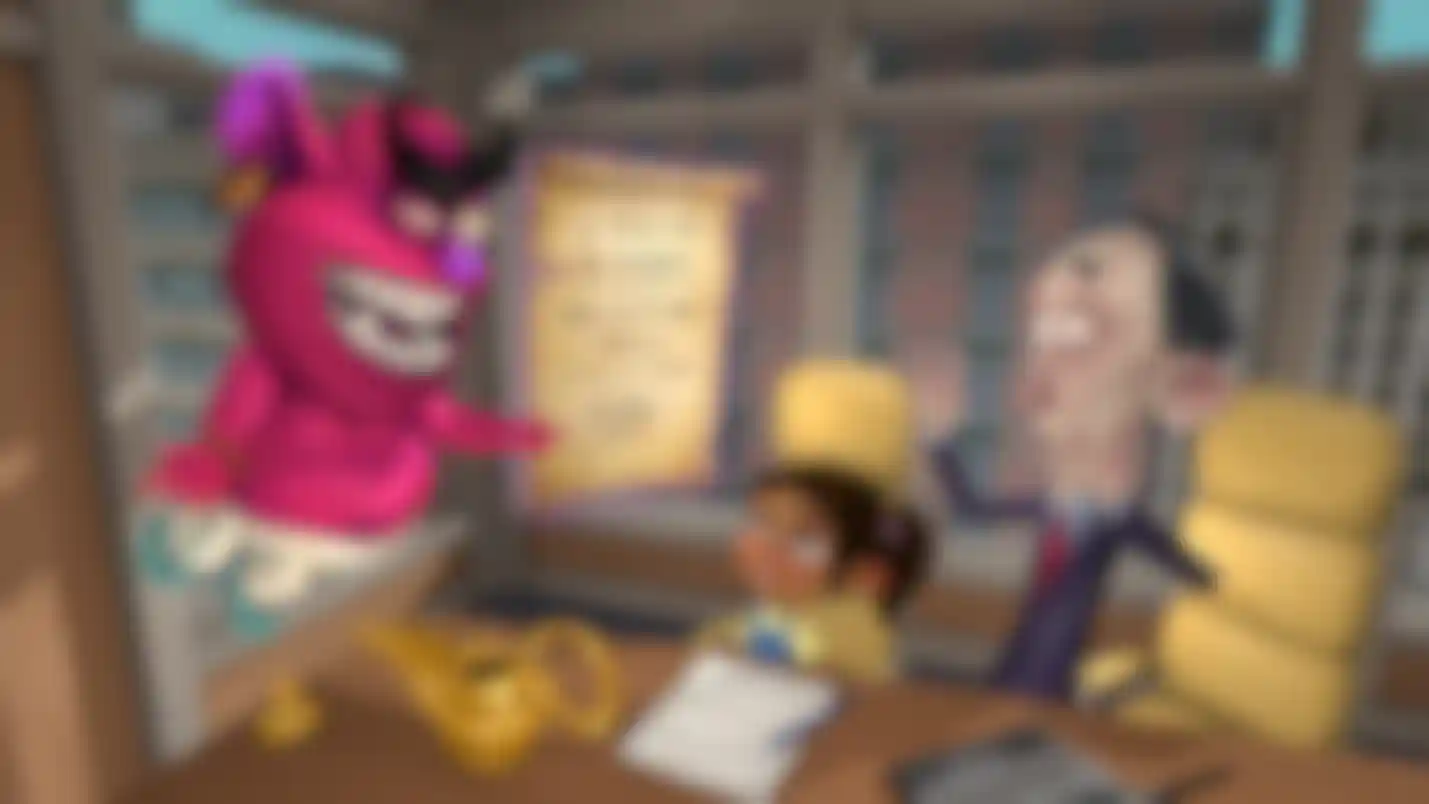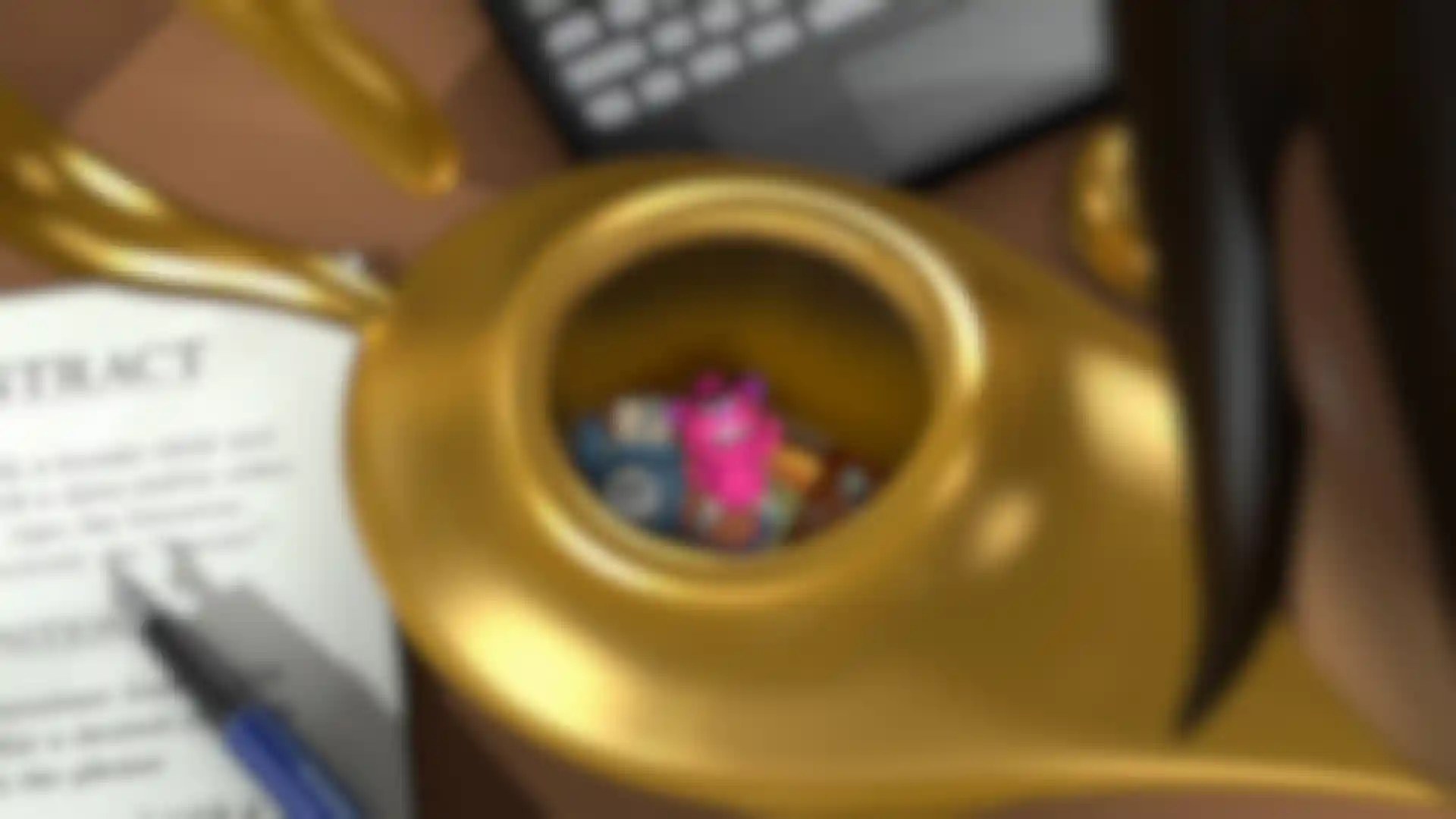
Creating the VR Short ‘Ajax All Powerful’ How Ethan Shaftel used Cinema 4D, ZBrush, Unity and more to put an immersive spin on the genie-in-a-lamp story.
Los Angeles-based VR filmmaker Ethan Shaftel has been blending film, interactivity and immersive design in his projects for years. His latest VR comedy “Ajax All Powerful” stars Henry Winkler (“Happy Days,” “Barry,”) and Chris Parnell (“Rick and Morty,” “SNL”) and launches August 20th on the Meta Store.
Created with a combination of Cinema 4D, ZBrush and Unity, the fully immersive, animated romp tells the tale of a genie (Winkler) who gleefully collects the souls of humans who summon him from his lamp until a little girl with a lawyer (Parnell) comes along with a different plan.
Produced by Shaftel’s company, easyAction, “Ajax All Powerful” was financed and co-produced by Beijing-based VeeR. We talked with Shaftel, who wrote and directed the film, about the making of the 15-minute comedy, and how this latest release reflects his unique, interactive approach to narrative VR.
The film already premiered at festivals, right? And you’ve also made other films.
Shaftel: Yes, the festival version of the film premiered at the 2020 Venice Film Festival, and it was also shown at the Annecy Animation Festival and Tribeca Film Festival that same year. My previous work includes “Kaiju Confidential” (Sundance 2019), “Space Buddies” (Tribeca 2019) and “Extravaganza” (Tribeca 2017).
How would you characterize your VR projects?
Shaftel: Even though I utilize a lot of behind-the-scenes interactivity, I think of my VR work as being principally cinema, in that the visitor is there to live through a protagonist and go through their emotions and catharsis. When people hear about interactivity, though, I don’t think they understand that it’s not always about giving the visitor choices or making them decide something. That puts their attention back on themselves instead of the protagonist, which I don’t want.

Instead, by knowing where you are looking, and triggering events by your gaze in a way that you don’t even notice, the pace can become breakneck, which is especially important for comedy. I want the whole experience to be very fluid with the sensation of barely keeping up because everything happens just at the point where you are ready for it. Every second has momentum.
Each of the VR narratives I’ve made over the last four years has been an attempt to build on the one before it. The goal is to use interactivity, movement and performance to create a perfect state of engagement in which the audience is fully focused on the story. Nothing disrupts the narrative flow, and the audience should be in a state of subconscious comfort with the world around them, without the sense of trying to “do the right thing.” Everything just works.
“Ajax All Powerful” is the first time I’ve been able to put together all the components of my vision for how I think narrative VR can work. I’m hoping that some of the techniques I’m playing with can transcend a single project and apply to other VR narratives and become part of the grammar of VR storytelling. That’s the ongoing project.
What excites you about the potential of narrative VR?
Shaftel: The interesting thing about VR narrative is how different it works than cinema. I prefer the word “visitor” to describe a viewer because it’s a better description for the relationship between the user and the work. In VR, there is always an interplay between concrete point-of-view, your location in the space and your psychological point-of-view.

In cinema, you have many directorial techniques—camera placement, lens choice and the pace of editing—to provide partial information about the scene to match what a protagonist would know or would see. And it all comes together to suggest a point of view that matches a protagonist.
Describe your concept and storytelling technique.
Shaftel: I had been thinking about interesting spaces in which to set a VR story, and I liked the idea of nested spaces, which led to the idea of a lamp and a genie. From there I explored the transformation of the viewer in the VR story world alongside characters inside that world.
I did something similar in “Extravaganza” but the technology was limited, so the visitor was stuck in the small inner layer, which was a small, toy-like box in that project, giving them only glimpses of the world outside.

The key technique I’ve developed to change the visitor’s location and scale is something I call a “Zip.” I even use that term in the VR scripts I write. It’s a very fast movement between two places, usually accompanied by a change in scale for the visitor. It’s a type of transportation visitors will have seen in VR, but the difference is that these movements aren’t’ controlled by the visitor themselves, it happens to them.
To make these Zips work seamlessly with the narrative, I have to follow certain rules, similar to editorial rules in cinema, like preserving screen direction across cuts. I only move the visitor towards or away from what they are already looking at. That’s where the interactivity comes in as the movement waits for the visitor to look at the right spot before triggering. So the Zips are like a cut in a movie, but I’m editing space instead of footage to connect two different spaces.
Tell us about your workflow.
Shaftel: All the animation was done in Cinema 4D, and we used ZBrush for character design. The programming and interactivity were built in Unity, and we used Adobe Premiere throughout for editing our storyboards and animatics, as well as creating all the video textures and sequences that appear on TV screens and surfaces in the movie.
The great thing about using Cinema 4D in VR production is that you can use it in several different ways. I used it during the writing process to plan and make previz animatics with very rough art to explore the spaces and block the action of scenes.


Next, I used the VR 360 video tools in C4D to render out frames of 360 video from different points of view. I took the C4D renders into Adobe Premiere to edit into a VR storyboard or animatic with temporary voiceover, sound effects, music and pacing. That’s really when you start making a movie, when you can improve the pace, really shape the individual scenes before you’ve invested too much time into the artwork or design itself.
That animatic process really becomes a rewriting process where you can experience a rough version of the full movie in a headset and then iterate on it to improve. I could share it with friends and just watch and get feedback, and by the time we were ready to record the real actors, polish the character art and animate the movie, I felt confident that the movie was working.

Full production was the next step. We recorded and edited Henry Winkler and Chris Parnell, and then brought the locked dialogue soundtrack into C4D to rig and animate the characters to match their performances. Because this is an interactive film, when everything was looking good in C4D, we exported the FBX file into Unity to add all the interactive authoring, spatial sound mix and final visual steps like lighting and particle effects.
What’s it like working with C4D and Unity together.
Shaftel: I think Maxon and Unity have done a good job of making their programs work together, and Maxon has made it a very straightforward process to export files into VR. I feel like we were pushing how large a single animation could be when being exported from C4D into Unity. Ajax is largely one unbroken, 15-minute animation, and it was exported as a single large FBX file from C4D to Unity. The way we did it worked surprisingly well and could be updated again and again as we polished animation.
What did you find most challenging when making this?
Shaftel: There is so much more animation to do when you’re making an entire world for the visitor to inhabit. It’s not enough to “please the camera” as you might in cinema, because the viewer can look anywhere at any time. All of the characters are live all of the time, so you have to be really brutal about where you put your production time, polish and energy. There is just not enough time to bring that life to every corner of the world at every second, so you have to prioritize painfully.
What’s next for you?
Shaftel: We are completing the festival run for “Ajax All Powerful” and its release, and now there is a new generation of headsets that allow you to move fluidly between VR and augmented reality. The team and I have been hard at work on a comedy that’s a mix of VR and AR called “Gargoyle Doyle.”
We have taken this idea of nested spaces one step further, so that the outer layer happens in your own home, where your space is transformed in augmented reality into a museum filled with virtual exhibits you can interact with. One of those exhibits pulls you inside into full VR.

We learned a lot with Ajax about how to use Zips, as well as new techniques for changing scale, and we are building on that with “Gargoyle Doyle.” We’re also playing with different levels of visitor agency at different layers of the experience. Sometimes you are fully embodied and active in the AR environment and characters look at you and speak to you, but when you go down into the heart of the narrative in VR, you leave yourself behind in a cinematic way to follow the story of Doyle.
“Gargoyle Doyle” will be appearing at festivals later this year and next year, and we expect a commercial launch on the newest headsets in early 2024. We’ve also written the scripts for the next two chapters of “Ajax All Powerful,” so now it is a trilogy of shorts that go to some interesting places because of what I’ve learned about each character during production.
The future for those other chapters really depends on what happens now as we release this film. Will audiences like it and buy it for their VR headsets or buy tickets at a VR arcade? Are there even enough VR users out there for a project like this to find an audience and be financially successful? If so, then we will probably find the funding to make the other chapters. If not, they’ll exist only in my desk drawer!
Credits:
Writer and Director – Ethan Shaftel
Lead animator – Frank Stringini
Unity Developer – Andy Runyon
Lead Designer – Scott Wetterschneider
Additional Illustration & Animation – Gwendolyn “Wynne” Gettelfinger
Composer / Mixer – Mckenzie Stubbert
Executive Producer – Jingshu Chen
Producers – Rosie Huang, Samantha Huang, Jane Huang
Voice Producer – Rene Veilleux
Ajax – Henry Winkler
Kleiner – Chris Parnell
Izzie – Suzie Rai
Newscaster / Misc. Voices – Monique Coppola